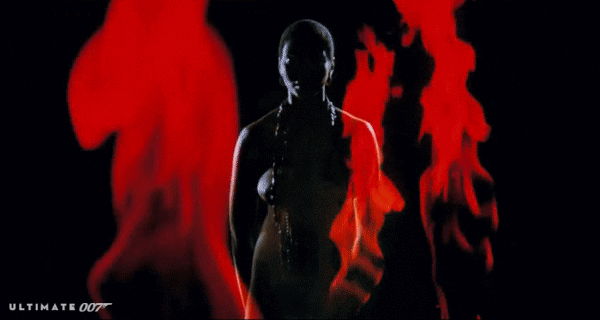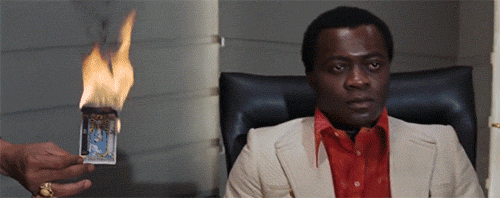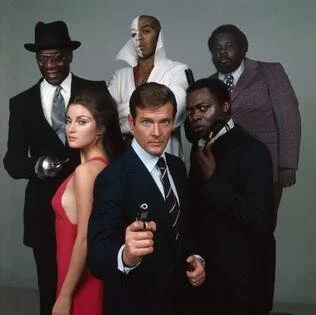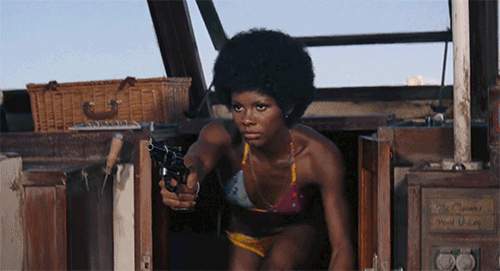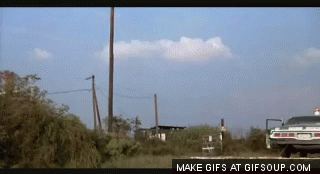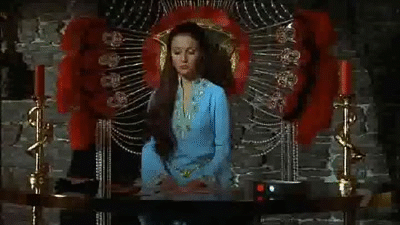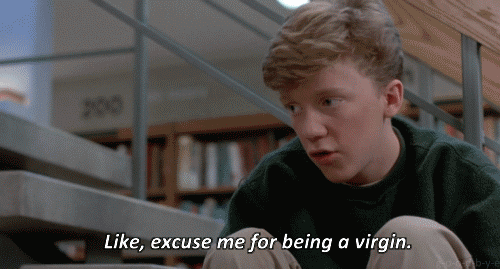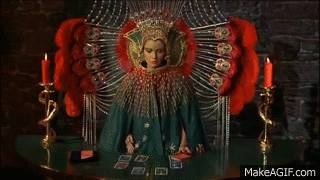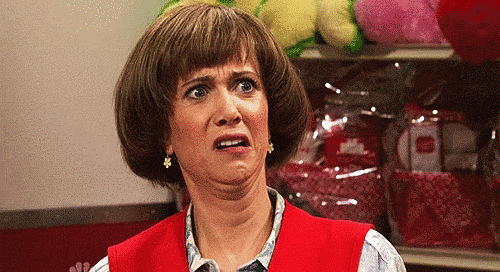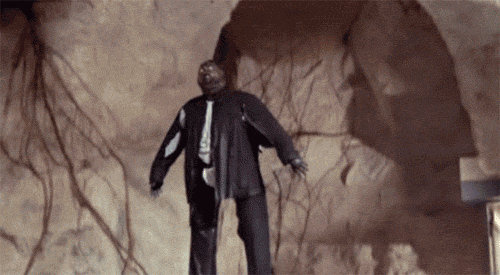Listen to the Raven Bond companion podcast here!
Released: June 1973
Producers: Harry Saltzman & Albert R. Broccoli
Director: Guy Hamilton
Written by: Tom Mankiewicz
Plot:
After the death of three British agents in New York, New Orleans and in the Caribbean island of San Monique, James Bond is sent to American to investigate the shady goings-on of the San Monique Prime Minister Kananga, and his links to a US drug baron known as Mr Big.
Famous For:
Roger Moore’s first appearance
Its influence by/appropriation of blaxploitation films
The use of Caribbean spiritual beliefs like Obeah and voodoo
THAT CROCODILE JUMP
Rarely has a Bond film so occupied a definitive time and space as Live and Let Die. Roger Moore’s first outing as 007 was also the first Bond film to feature a predominantly African-American cast, including Bond’s first black love interest. On the one hand, that is commendable - when the apartheid government of South Africa cuts your kissing scenes because it depicts a mixed race couple, you’re doing something right.
On the other hand, the film’s influence by the blaxploitation films of the era means it now makes for uncomfortable viewing at times. One could argue that its storyline of a heroin trafficking ring is far more realistic and grounded than the previous three films - all of which featured Blofeld attempting to take over the world via an elaborate plan often involving space - but it also depicts black people as gangsters and criminals.
In Yaphet Kotto, who plays the upright politician Kananga and (spoilers) his criminal alter-ego Mr Big, the series finds an eloquent and charismatic villain who remains underrated in the franchise. There’s a distinctly American capitalist drive to his villainy - his aim is to flood the US market with his own free heroin, drive the Italian mob families out of business, then jack up the price.
He creates elaborate disguises, covers his tracks with an army of paid lackeys and even kits out his home turf with an underground lair, complete with monorail - and yet, his target is not Cold War superpowers but everyday people he can attract to the white stuff.
This ruthless entrepreneurship is a new angle for a Bond baddie, but would be echoed by villains to come: think drug lord Franz Sanchez in Licence to Kill, media mogul Elliot Carver in Tomorrow Never Dies or pipeline heir Elektra King in The World Is Not Enough. Kananga’s uniqueness is his belief in the occult - not just the use of Baron Samedi as a method to keep local people compliant about his poppy fields in San Monique; but also in a genuine sense, due to his use of Solitaire’s tarot powers to make decisions.
Kananga also has a series of capable and memorable henchmen: Julius Harris as Tee Hee, with a pincer hook for an arm; Earl Jolly Brown as the hoarse-voiced Whisper; and Geoffrey Holder as the spooky, inimitable Baron Samedi. They are all great to watch.
Gloria Hendry’s character of Rosie Carter probably suffers the most in terms of character depiction - a double agent also working for Kananga, Bond suspects her from the beginning, but still sleeps with her to get information.She’s portrayed as in over her head in this secret agent business, and a tad ditzy. That’s not exclusive to black women in this franchise, as we’ll see once we meet Mary Goodnight in The Man With the Golden Gun.
But the one time Rosie actually shows spy initiative, by training her gun on Quarrel Jr on his boat when she finds his secret weapon stash and thinks he must be working for Kananga, Bond roundly mocks her for suspecting his friend. But when they got on the boat, Bond never said he knew Quarrel Jr (the son of Quarrel from Dr No); nor did Quarrel Jr speak to Rosie before that point. She’s legitimately right in being suspicious - and Bond is just being an asshole.
This is the most badass shot in the whole film.
Speaking of Quarrel Jr (Roy Stewart), he and the FBI agent Harry Strutter (Lon Satton) were included in an effort to make sure there was some diversity among the “good” guys. And screenwriter Tom Mankiewicz also created one other character to depict a puffed-up white racist as comic relief - Sheriff J.W. Pepper.
Coming before Smokey and the Bandit and The Dukes of Hazzard, Sheriff Pepper is a similar comedic pisstake of that certain type of hick Southern cop. He’s a ridiculous, pompous figure that the audience is meant to see as a fool.
It’s fair to say that the film mocks ignorant rednecks like Sheriff Pepper, and toys with him by having Bond frustrate him at every turn, until Pepper is an emotional wreck. But the case could also be made that it plays issues like racial profiling for fun - because seeing J.W. spit tobacco and tell a black driver he assumes it’s not his first time being pulled over by cops sure does feel uncomfortable.
The boat chase sequence in which Sheriff Pepper turns up is the big budget stunt of the film - and they make the most of it, sending jet boats skidding through backyards and weddings, as well as some accidental world record jumps.
17 of the 26 boats built for stunt rehearsal and filming were destroyed. Nice.
However it’s perhaps not as best remembered as the stunt that allows Bond to escape by boat - the crocodile jump.
Knocked unconscious and taken to Kananga’s crocodile farm - which cleverly conceals a heroin processing plant - Bond is left out on a small island in the middle of a moat full of crocodiles (Tee Hee’s delight in tricking Bond to walk out with him as he feeds raw chicken to the beasts is actually joyous).
The croc farm was a location found while scouting in Jamaica - its ominous “Trespassers Will Be Eaten” warning sign featured in the film is what drew the production team to it. Mankiewicz was inspired by the owner Ross Kananga to name the film’s villain after him, and to create the idea of Bond escaping from crocodiles.
Of course, Kananga was the only person willing to actually DO the stunt. This excerpt from a DVD making-of documentary ends with all five of Kananga’s attempts, but is worth watching the whole way through for some totally batty behind-the-scenes gossip. Roger Moore even tells of a close call when they thought they’d pulled all the crocs out of the lake for his scenes, but they hadn’t:
As someone with no knowledge of New Orleans, I remember loving the inclusion of the jazz funerals in the film as a kid. I was fascinated by the slow pace of the mourning march, particularly in its first appearance. When the British agent asks the chap next to him “Who’s funeral is it?” there’s the flick of a knife and a quiet “Yours” before he’s stabbed in the side. His body is then snatched up cleanly by the coffin, leaving no trace.
The sequence is later repeated with Strutter, which again I loved as a kid - and to be honest, I still do. “It’s all organised! They’re all in on it!” To me, it seemed an incredibly clever way to hide criminal acts in plain sight.
The fact that the band - Dejan’s Olympia Brass Band - was the real deal, makes it extra cool:
The use of voodoo is perhaps more of a controversy. Producers Saltzman and Broccoli, as well as writer Tom Mankiewicz and director Guy Hamilton travelled to the Caribbean to get an insight into local practices and customs, including Haitian voodoo, but it’s a movie, so there’s little room for nuance when putting such spiritual practices onscreen.
What’s particularly interesting is that the film doesn’t interrogate whether practices like tarot are “real” or not, they are just accepted as fact. If you are a person who subscribes to those religions, you could definitely argue that they were simplified and exoticised for the screen. But if you are a skeptic, there’s also an argument to be made that the film is essentially agreeing that “magic” is real.
Which brings us to the magical Jane Seymour.
“Snap!”
Solitaire has the power of “Obeah”, which according to the Wikipedia definition is “a system of spiritual healing and justice-making practices developed among enslaved West Africans in the West Indies. Obeah is difficult to define, as it is not a single, unified set of practices.” In this film, it’s linked with Solitaire’s ability to read tarot cards and see the past, present and future.
The film never interrogates the idea that Solitaire is gifted with “the sight”; it’s just accepted as fact. Also accepted is that her virginity (or one assumes, an intact hymen) gives her this power, and having sex means she loses it. The emphasis on “purity” gives me the yucks, but there’s no denying Jane Seymour imbues Solitaire with a suitable innocence.
And here’s a doozy of a consent pickle.
At their first meeting in New York, Solitaire tells Bond to draw a card. He draws The Fool, which is glorious. He then draws The Lovers, and inquires whether it means the two of them. Solitaire is shocked, but as Bond is manhandled out of the room, he jovially promises to be straight back.
Solitaire later draws The Lovers card while doing a reading for Kananga about Bond’s arrival on the San Monique island to investigate his mysterious crops. She is shocked and a bit scared, and so lies to Kananga, telling him she sees his death. But of course, Bond doesn’t die, Rosie does instead, cut down by a very spooky coconut scarecrow armed with cameras for eyes and a gun for a tongue.
So when Bond rocks up at her chalet later that night, having hang-glided in with a convenient reversible jacket, she is primed to think something will happen between them. So when Bond pulls the whole “Pick a card from my stacked deck of 100 per cent The Lovers cards”, she is primed to believe it is inevitable; that it is fate.
NOW I’M NOT SAYING WHAT BOND DID WAS RIGHT.
He did trick her into sex. It’s not cool. It’s kinda creepy.
But I would make the case that Solitaire was chafing against Kananga’s strict control over her every movement anyway. For goodness’ sake, he made her do her hair in elaborate braids and top knots; not to mention an overly-vigorous application of eye make-up and those impractical costume changes.
Normal workwear.
Kananga also threatened to rape Solitaire when he was done with her services - and weirdly implied that perhaps he’d done the same with her mother before her.
Wait… were they implying Kananga was Solitaire’s Dad?
Besides, it turns out Solitaire is very sex positive. Once she gets over her initial wide-eyed terror at having done the nasty with a man twice her age, she asks for a round two before they had to leave. Roger Moore, all Riviera tan and extraordinarily large nipples, is all class.
Later on Quarrel Jr’s boat back to New Orleans and at the end of the film on the train, she very much expresses an active interest in this brand new non-card based hobby.
Of course, she’s recaptured by Kananga/Big’s goons in the Big Easy, and returned to San Monique to face the otherworldy justice of Baron Samedi.
Bond arrives in time to save her, having rigged bombs to blow up Kananga’s poppy fields, but first we’re treated to the spine-tingling sight of the spirit of the dead being summoned from a grave. It’s all a cheap trick, but the sight of the Baron’s eyes rolling back in his head despite Bond shooting part of it off is still enthralling. Bond shoots the whole figure apart, but then another rises in its place - and it’s the real one this time. Of course the arrival of a white man to save a white woman in a white dress from a black spirit figure is again on the nose, but as a movie scene, it’s still a belter.
And just as a sidebar, I want to pour a bit more love on Geoffrey Holder, the Trinidadian-American actor, dancer, artist, singer and more who played Baron Samedi. His nearly 2m height took nothing away from his ability to move - Holder embodies both the lightness and earthiness of a spirit of the dead; the man who cannot die. This clip is a supercut of all of his captivating laughs as Baron Samedi - they’re both terrifying and infectiously seductive at the same time:
After dispatching the Baron into a coffin full of snakes, Bond uses the fake grave trick to get he and Solitaire into Kananga’s lair beneath. It’s a brief escape; very soon the villain welcomes them cordially into his high-tech bunker for a drink, before stringing the pair over a pool, slicing Bond’s arm and calling in the sharks.
But Bond still has the only gadget he was provided with by an absent Q (the last Bond film Desmond Llewellyn would miss until he died), and is able to cut his way out of the ropes, save Solitaire and launch into a fight with Kananga, which ends with one of the dodgiest death scenes in the franchise - having a gas pellet shoved in his mouth which blows him up in both literal possibilities.
Yaphet Kotto himself has said he disliked the way Kananga was dispatched, and you can’t blame him. He was an unfortunate victim of the 1970s OTT Bond, where there was no such thing as “too silly”.
There’s also an interesting insight from Kotto in this Guardian piece - he discusses being asked to hang back from promoting the film after its release due to concerns about a black villain upsetting audiences. “I went through a lot of goddamn emotional hell because they were afraid people would be angry that a black guy was not being Sidney Poitier,” he said. Poitier, of course, was famous for playing the kind of upstanding black characters white people had a very hard time objecting to. You feel the frustration of Kotto having to play a bad guy with a script that centred a white male hero - and then not even getting to enjoy the ground-breaking aspects of it (representation in Bond films; first African-American Bond villain).
And so what of the white male hero himself? What do we make of Roger Moore, the most appropriately-named man ever to play this relentlessly slutty man spy?
If you can get past the smarminess and occasional assholiness, he’s pretty fun. Already older than Sean Connery when he did his last Bond film, Moore made the sensible decision to not try to copy the Scotsman’s “blunt instrument” take (abetted by filmmakers here who keep him out of a tuxedo and have him order a Bourbon instead of a vodka martini), and instead play up the “gentleman spy” angle.
Moore is lanky where Connery was powerfully built; smooth-skinned where Connery was hairy. The physical contrast probably also contributed to his success in the part - at seven canonical films, he’s still the Bond with the most notches to his belt, even if the later ones are mixed.
He also introduces a trend of Bond smoking stogies, which can often come in handy when confronted by sneaky bathroom snakes:
Live and Let Die could safely be described as a film with many batshit crazy elements. It sets a template for the rest of the 70s; even though the blaxsploitation genre it’s so heavily influenced by would lose popularity by the end of that decade.
Where you stand on the film may depend on where you sit on those very “of its time” elements. In no way can I put myself in a person of colour’s shoes and think for them, but personally, the fact this film did have so much African-American representation, including Bond and Rosie’s sexual relationship, means it served a purpose in the franchise to expand diversity.
One thing that cannot be denied - in any conceivable way - is the genius of its theme song. Paul McCartney was hired to write it, and he was so expensive the producers couldn’t afford regular composer John Barry to do the rest of the score, and former Beatles producer George Martin was given the job.
But Live and Let Die is an absolute belter, an instant classic that only gets better with age. Like the film itself, it has disparate elements: soft ballad call-and-response; a savage denouement into the chorus portion; a funky bridge; and that rollicking rock and roll riff. But despite the wacky ingredients, it all works. Maurice Binder’s title sequence puts a black woman first and foremost, her head flicking to that of a flaming skull. It’s metal AF, the first proper rock song to open a Bond film, and a perennial favourite in top Bond song lists.
Thank you for reading this instalment of the James Bond Retrospective! If you enjoyed it, you can sign up to support the series and my other writing/podcasting efforts via my Patreon page. Thanks to all of you who are already members; your support is truly invaluable.
You can listen to the companion Raven Bond Live and Let Die podcast here:
Stu and I have are also ranking the Bond films as we watch and podcast about them. Here’s how we stand:
See you next time for The Man With the Golden Gun!
